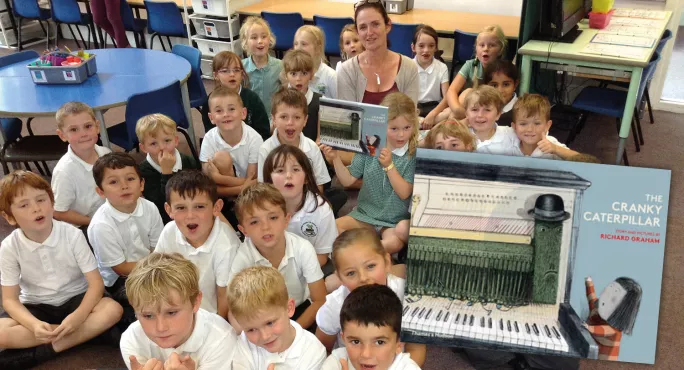- Home
- The class book review: The Cranky Caterpillar
The class book review: The Cranky Caterpillar

On the first day of a new term, the children were intrigued by the book’s cover design, quickly deducing that the story was about a little girl, a piano and “a large green thing with a face”. Riley saved the day by reading the title of the book and we guessed that the sad face belonged to the cranky caterpillar.
Richard Graham’s beautiful illustrations and prose reveal a delightful tale about a little girl called Ezra who, upon hearing some sad blue music coming from the piano, lifts the lid to find a cranky caterpillar.
Both Ezra and the pupils were transfixed by the caterpillar’s problem. “I have walked over five thousand miles in this piano,” he said, “searching for a happy tune. But it is useless...I am STUCK inside this piano.”
“He needs some friends,” suggested Riley.
“Ezra can lift him out,” said Maddison.
Milo asked: “How did he get in there in the first place?”
Richards Graham’s initial choice of colours add to the sense of gloom and misery. Eryn commented that she could see lots of shadows in the picture. Riley was more matter of fact: “I can hardly see the pictures, because they are so dark.”
Ezra’s initial attempts to cheer up the caterpillar are unsuccessful, until she comes up with the idea that the caterpillar needs some friends.
Eryn’s clever guess that “Maybe she is getting loads of instruments to make friends with the caterpillar, to make him happy,” was spot-on. Pablo Tuba, Gary Gee-tar and Wassily the Violin are invited by Ezra to form a band.
As I turned the page, the children’s faces lit up as the illustrations burst with colour, depicting the happy music being played. The mention of a band prompted a few air guitars to be played as the children got involved in the story and hoped the caterpillar would stop being cranky.
Another plot twist kept the children’s attention: once the happy music began, there was a big BOOM inside the piano and the caterpillar disappeared.
After much discussion, the children were still none the wiser. They didn’t guess what might have happened, despite Riley trying to suggest he had seen the caterpillar disappear off the page of the book.
I continued to read and the word “fluttering” made many synapses in front of me connect. “Caterpillars don’t flutter, but butterflies do,” said Eryn.
“The ‘boom’ was when he went into his cocoon,” suggested George.
“And then he burst!” said Daisy.
The children quickly made the connections with their experiences hatching butterflies last year, and were delighted to see a colourful, musical butterfly illustrated on the next page. “Look at his wings” said Scott. “They are covered in music.”
Resource for creativity
This story is an original take on the familiar theme of caterpillars turning into butterflies, adding intrigue and excitement. The book could be used to develop creative-writing opportunities, especially when Ezra is trying to think up different ways to make the caterpillar happy. It could also be a great stimulus for art and music activities - often marginalised in an already over-prescribed infant curriculum.
The line-drawing illustrations have a slightly cartoon-feel. They are made up of simple lines, but make complex use of colours to continue the story through the pictures.
Prior to reading the story, I was playing some sad piano-style music as the children came in from play. There are plenty of follow-up opportunities to talk about different styles of music and how they can make you feel, alongside the different instruments in the book and the sounds they make when played individually or as part of a band.
The class liked the ending.
“I liked it when they played the happy music,” said Rowan.
“I liked it best when the butterfly popped out of the piano,” commented Autumn.
“I think that this book would be good for other children to listen to,” said Ollie.
Jago summed up the overall thoughts of the class, influenced by the choice of language Richard Graham uses: “There are some bits in the story that are really sad, and some bits that are really joyful.”
Jane Flood is head of learning at Netley Marsh CE Infant School in Southampton. She was reading The Cranky Caterpillar with Osprey Class on their first day of Year 2
Keep reading for just £1 per month
You've reached your limit of free articles this month. Subscribe for £1 per month for three months and get:
- Unlimited access to all Tes magazine content
- Exclusive subscriber-only stories
- Award-winning email newsletters



